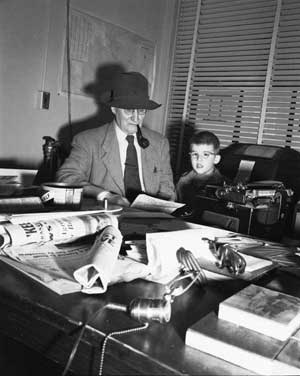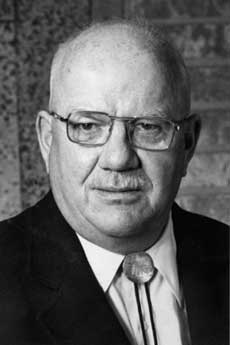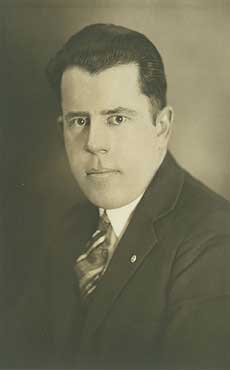 By Louise Brinck Harrington November 26, 2003
The headlines flashed across the front pages: "Grand Jury Demands Arrest of Police Captain;" "Police Chief Charged with Keeping Bawdy House and Malfeasance," "Grand Jury Requests Removal of District Attorney." Fifty years later, it's difficult to believe such things happened in Ketchikan. The newspaper stories, datelined December 1953 and January 1954, read like fiction and reveal details of one of the sleaziest chapters in the town's history. 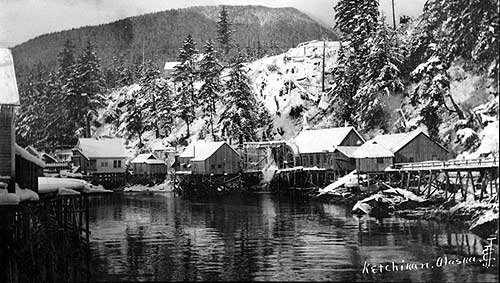 Photographer: John E. Thwaites - Donor: Virginia McGillvray Estate, Courtesy Tongass Historical Society
At the beginning of the hearings Folta, a straightforward no-nonsense judge, told the jury he wanted a thorough investigation of vice and corruption in local government. "You are the bulwark between the public and the lawbreakers," he told the jurors. Weeks later the judge accepted the final report, and expressed his satisfaction to the jury. "The public owes you a debt of gratitude," he told them. Most likely the report more than satisfied Folta because it:
The "oldest profession" came to town around 1900 and established itself just north of today's tunnel in the area then known as "Newtown," according to historian/author Patricia Roppel. In those days, Ketchikan was a rough, frontier village inhabited mostly by men-miners, fishermen, and sawmill and cannery workers-who tended to gravitate toward saloons and brothels. As the town grew and prospered, the red-light district kept pace. As law-abiding citizens began to complain about noise and rowdy neighbors, the newly formed city council flexed its muscles and ordered all madams and prostitutes to move to the south side of Ketchikan Creek. That was in March of 1903. Soon small clapboard houses and shacks appeared along the creek. Early photographs show that over each small house hung a large globe, engraved with the names of its residents. Although difficult to tell from the photos, some of the names may have included Margot,
By 1920, according to Roppel, at least 21 brothels with 37 prostitutes operated on what was now officially referred to as Creek Street. City officials soon found it necessary to impose rules on the red-light district. The women could not shop downtown after six in the evening; they could not walk down the street en masse, but only alone or in pairs; they could not visit and socialize with each other after four o'clock in the afternoon. Despite such restrictions, business on the creek boomed. Soon the bawdy houses, bootleg joints and card rooms spread to Barney Way and Stedman Street, to Main and Mission and all over town. The times were wild and today old-timers love to talk about them. Stories are told of "rumrunners" who delivered booze to creek-side whorehouses and other "blind pigs" and speak-easies around town; and of bootleggers who smuggled liquor from Prince Rupert, stashed it on Gravina or Pennock, and later brought it to town in rowboats and unloaded it through trap doors. Stories are told about "moon-shiners" and stills, bathtubs of "mash" and bottles of home brew. And about the empty bottles that drifted nightly down the creek and washed into Thomas Basinnot to mention the occasional body or two! It is no wonder that by 1925 Ketchikan had earned a bad reputation. "Senator Hunt Says Ketchikan's Wicked!" headlined the Ketchikan Alaska Chronicle on April 24, 1925. According to the newspaper, Senator Forest J. Hunt stated on the floor of the territorial senate that "Ketchikan Alaska is a terrible town. It is vice-ridden and corrupt. One might even gather that it is about the worst place in the world." Shocking testimony, given that Senator Hunt lived in Ketchikan and considered it his hometown! The town's reputation spread. In 1926 the Los Angeles Examiner ran an article about "gamblers, liquor dealers, and red-light women" in Ketchikan. The Examiner stated that vice in Alaska's First City was "defiant" and "arrogant," and the town was "the worst pest hole in America." The unwanted publicity led to an uprising of local citizens, many of whom were mothers concerned about raising their families in such a deplorable place. The citizens sent a petition to Washington, D.C.: "Bootleggers are all around us; almost every taxi carries liquor; sporting girls are in houses next to ours. We have appealed to the city officers
In response, a federal grand jury held hearings in Juneau and found that in Ketchikan "the prohibition force is lacking in numbers to carry on its work" and recommended another deputy marshal and an assistant district attorney be stationed here permanently, according to a 1926 Chronicle article. The promised attorney arrived-an aggressive man named Howard Douglas Stabler, who went after houses of vice with a vengeance. "Bawdy Houses Face Nemesis Says Stabler" read a Chronicle headline. Stabler apparently conducted a one-man abatement campaign, closing down brothels, bootleg joints and taxi companies. Yet his efforts did not last and within a few years, 33 houses were open for business on the creek. Though World War II again closed the red-light district briefly, by the end of the war it was back in business, full steam ahead. In 1948, the Ketchikan Ministerial Association wrote a letter to the City Council: "Creek Street is open again." Expressing a concern for young people of the community, the local ministers pleaded with the council to do something about vice. In 1952, the U.S. Coast Guard, concerned about the health and well-being of its men at Base Ketchikan, contacted an agency called the American Social Hygiene Association (A.S.H.A.) and requested an investigation of venereal disease and drug addiction on Creek Street. In its subsequent report, the A.S.H.A. found that vice and corruption in Ketchikan was worse than in 95 percent of other U. S. cities. The Association also classified the town as "bad" in relationship to prostitution. The city council responded by imposing more rules on the Creek. Longtime Ketchikan business man Wally Kubley recalls that in the '50s "the girls had to shop and be off the street by twelve noon and if they wanted to go to the show, it had to be the second show. And they couldn't go in the bars." Emery Tobin arrived in Ketchikan in 1920 at the age of 25. A public-minded citizen, he quickly became involved in community affairs. By the 1940s he was well known as publisher of the Alaska Sportsman, a Boy Scout leader, charter member of the Ketchikan Rotary Club, and someone who wanted to reform local government. By this time there were rumors everywhere about graft among public officials and police officers taking "protection money" from prostitutes. Motivated by local ministers and the American Social Hygiene Association, the self-confident Tobin called for an investigation of the police department. When nothing happened Tobin
But Tobin could be abrasive and offensive, and many people did not agree with him. One person Tobin offended was Creek Street resident Annie Watkins, who began writing letters of her own. "I don't think whatever is on Creek Street, it don't hurt Mr. Tobin," Watkins wrote to the editor of the Ketchikan Daily News. "I am sure Mr. Tobin don't visit anyone on Creek Street. After all a man like him wouldn't because we are just the poor underdog and a target to be shot at." Longtime Ketchikan resident L. L. Winnie also disagreed with Tobin and wrote that Creek Street "is not an evil but a necessity, an outlet for the hell with which we were born." Another citizen advocated that Ketchikan solve its prostitution problem by becoming a "blue law town;" in other words, giving prostitutes and other "undesirables" blue tickets and shipping them out of town. Both the Ketchikan Alaska Chronicle and the Ketchikan Daily News published letters-to-the-editor on both sides of the issue and then added their own editorial views-on opposite sides. Publisher of the Chronicle, Bill Baker, wrote anti-Tobin editorials, while Sid Charles, publisher of the Ketchikan Daily News, supported Tobin's clean-up campaign. "Word must not go out that this is a 'loose town,'" Charles warned in a 1949 editorial, "especially in view of [future] pulp mill development." By the time the Grand Jury convened in the fall of 1953, feelings were running strong. The Daily News published an editorial supporting strong-willed Judge Folta, who over the years had expressed frustration with previous grand juries that did nothing but "rubber stamp" recommendations of corrupt city and federal officials. This time Folta meant business and everyone knew it. When the 1953 grand jury attempted to submit another "rubber stamp" report and adjourn, Folta called them back into session. He demanded they take as much time as needed to get the job done. "This has become a showdown battle between the good people of Ketchikan and the crooks," the judge added for emphasis. The Daily News picked up the quote and highlighted it in great bold type. When dust from the hearings settled the police chief and captain both pled guilty to reduced charges-conspiracy to permit prostitution-and left town. The district attorney remained in Ketchikan, but resigned his government position and went into private practice. True to his self-confident nature Emery Tobin, in a 1965 taped interview, claimed sole credit for being "the leader of an investigation which resulted in an almost 100 percent clean up of law enforcement agencies [in Ketchikan]. Seven bawdy-house operators had their places abated and the red-light district was abolished." 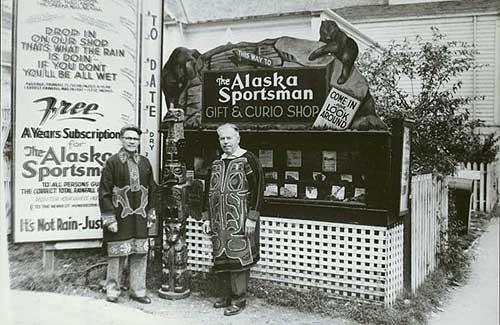 Donor: Pat Roppel, Courtesy Tongass Historical Society...
The Ketchikan Ministerial Association determined that the 1953-54 Grand Jury hearings accomplished a lot, but did not go far enough. The ministers called for another investigation and additional hearings into who owned (and was benefiting from) buildings that were still being used for illegal gambling, bootlegging and prostitution, according to the Ketchikan Daily News. And there were other dissenting voices. In a 1956 letter-to-the-editor, Creek Street resident Annie Watkins took Tobin to task: "If some of our citizens would mind their own business and stop running around, up and down the streets, trying to make trouble without a cause, people could live in peace." Watkins went on to say that Creek Street may be "cleaned up" but the girls were still around. "You have squashed the mud and it flew all over town," she wrote. And with much passion Watkins defended residents like herself who continued to live on the creek: "We too have a soul, heart and feeling." To this day old-timers remember and take sides. "Tobin was against anything that was any fun," recalls longtime Ketchikan resident Mary (Berry) Van Winkle. Though Van Winkle says this with a chuckle, her tone is serious. Many of the "girls" were good people who did a lot to help others, she says. Walt Bolling, who served on the local police force in 1953 and lives in Ketchikan today, summed up the times by saying they were both good and bad and the people involved were both good and bad. The times were "controversial," he says, "but the people were just like us. They didn't want violence anymore than anyone else did." At least the shocking headlines of vice and corruption are gone and Ketchikan's reputation has improved considerably.
|
||||||
